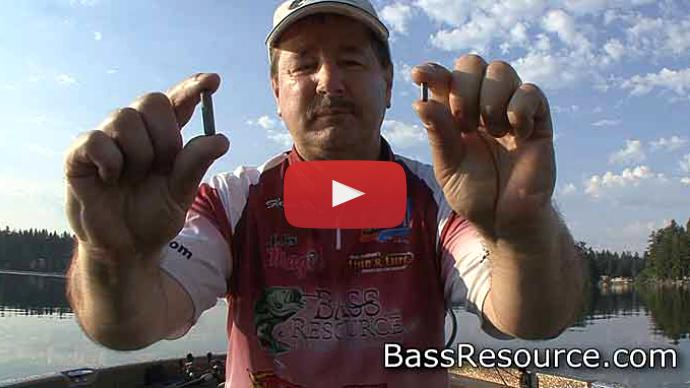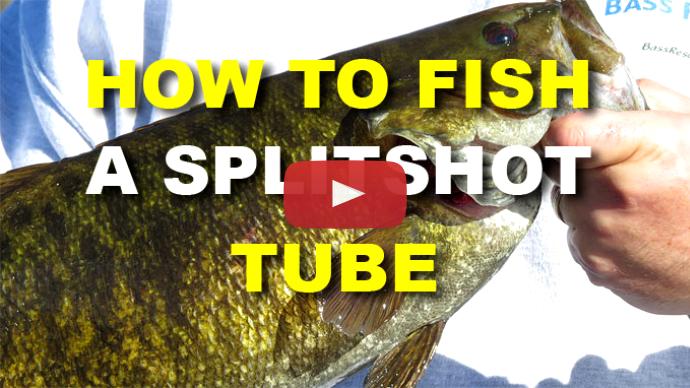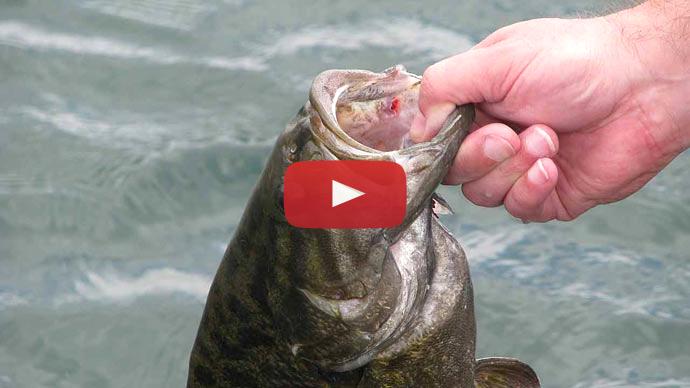And there we go! That's all it takes. This guy could not resist a little split shot grub. Look at this. There we go. Here we go. That splitshot grub. All we need to do here, is bring this guy in. Look at that. Could not resist a little split shot grub, I'm telling you what. That's what we're talking about today, how to catch fish on a splitshot grub.
Hey Folks. Glenn May here with BassResource.com and today I want to talk to you about fishing a grub split shot style, or mojo rig style.
This is...what we're talking about is a cylindrical weight, about 18 inches above the hook. If you don't know how to rig this, I've got a video that talks about rigging grubs. It's linked underneath this video. You can go check that out later if you want to learn how to rig this.
But right now we're going to talk about what equipment and gear we're gonna use. And then we're gonna, I'm gonna show you how to fish it.
So starting right off here we've got a 3 inch grub. I'm using a 1/0 extra wide gap thin wire hook. Nice and thin. That's important in this setup. It's a finesse setup, so we don't need a real heavy hook that's gonna weight this down because we want this to be actually above the bottom of the lake a little bit. So a light wire hook is what you need. I know a lot of people like to use fluorocarbon...you know, that's fine. Knock yourself out. I'm not saying anything’s wrong with that. If that's what you use then go ahead and do it.
I don't do that because I want this to come up off the bottom, much like a Carolina rig--this is just a baby Carolina rig. Think of it that way. That bait's gonna come up off the bottom and then come back down. The fluorocarbon's got some weight to it. It's not gonna come up off the bottom as much as you would say, this hybrid approach. Braid sounds like a good choice when you're talking about that, because braid is actually buoyant and would actually help bring the bait up a little higher. But we're fishing in real clear water. Braid looks like rope in those kinds of conditions so we're not going to use that today.
Then I got it about 18 inches above. That's where I have the weight. The reason being is I want the fish to focus on the bait, and not the weight. And I also want the bait to be, to freely move about as much as possible. Be as natural looking as it can be. If I bring that bait up much close- the weight up maybe to 10 or 12 inches, then it's starts to inhibit the action of the bait, and that will kind of kill the action. So, about 18 inches up and we're good to go.
Again, 6 pound test line, we're using that to match this light wire hook so to finish that off, we want to use a rod that's a medium light action rod. It's got a lot of give to it, a lot of play to it, and that way when you set the hook, you're not going to straighten it out nor you going to break the line. This rod will have that give that it needs to fight the fish back with that light setup. Just a spinning outfit. That's what we're using today.
So that's the gear. That's the equipment. Now let's go fish it.
Alright. What I have here is I'm fishing an area that's got a rocky bottom with some weeds in it. And that's a great place to fish a split shot rig because the weight is going to slide through those rocks a lot easier. They're not gonna get hung up as other weights would. And it's going to go through the weeds well. And the bait of course, is Texas rig so it's not going to get hung up as much either, so it's a great place to fish this rig.
All you're gonna do is your gonna cast it out there and when you cast it just bring it back, let the weight kind of settle down a little bit, and then it's a lob cast. It's not a real hard cast. You're not trying to win any distance competitions here. In fact, if you throw it really hard, that weight and the bait, they're going to twist like this in mid air and they're gonna get all tangled up before they hit the water and it's gonna ruin your presentation. So, don't try to throw it out there really far, it's just a lob cast. If you've thrown Carolina rigs, you know what I'm talking about.
And once it hits the water, you're gonna watch the weight. Watch where the line hit the water, let it fall and slack line, and cock the bail over. But other than that just watch it fall straight down on slack line. And what you're gonna do is you're gonna watch for the line to jump, pop, twitch, anything odd like that, usually that's when a fish hits it. They'll hit it when it falls. You're gonna see it that way.
If you do, just reel up the slack and set the hook. And you don't have to set it really hard. You know, you're using a light line, you're using a light hook. This is a medium light action rod. So you don't need to set it really hard. It's a light hook set. It's about like that, it's a moderate hook set. If that at all. Some people just reel down on it, and they just reel it in faster. Or they just bring the rod sideways like that, which is called a sweep set. It's not much of a hook set at all. However you do it, just make sure you don't hit them really hard.
Okay, so I'm going to show you the first one retrieve to use. This is the one that made the split shot so popular back in the 80's when they first came out. So here I've cocked the bail. I'm watching the line fall right where it goes in the water, making sure that it doesn't twitch, or jump, pop.
Okay, so now it's on the bottom. What I'm gonna do is I'm gonna lift the weight up, and all's I wanna do is reel the weight just off the bottom, keeping it just off the bottom, just like that. Let the grub, let the tail just wiggle back and forth and do it's work. The grub's gonna look like a little bait fish swimming in the water. I'm gonna keep it above the weeds too. If you're fishin' over weeds or a big flat, it's a great way to fish it just above the weeds, you're not going to get tangled in there like you would a crank bait.
And in fact, anywhere you fish a crank bait, this is a great rig to throw. You know, it's funny...with finesse techniques, a lot of people think that it's really slow fishing but here, I'm just cranking back. So you can actually cover water just as fast as you would with a crank bait. And this is a great search technique. Great way to find fish. You can do it this way or say for instance you fished an area with a crank bait and the bite dies off, go back through that area with this rig. You can just pick right up right where you left off and keep catching fish. Okay, so that's what everybody used to fish it this way when it first came out, and it's still productive today.
Another way to do this...again, I've thrown it out there, I'm watching the line, it hits the bottom. Now all's you're gonna do is lift the weight up and let it drop. Lift it and let it drop. And when you do that, lift it up slowly, you don't pop it up. Lift it up slowly, and then follow the weight back down with the rod tip. You want the rod to fall about the same rate as the weight. And reel up slack as you do that. So you don't want to move the weight with your reel. Just let the weight drop naturally.
Now, the reason you want to do that is a lot of times the bites happen on the fall. If you're maintaining contact like that, and this is what people call letting something fall on a semi-slack line by the way. If you maintain contact with it, you're more apt to detect the bite. So it's worth learning how to do.
Let me show you how to do that. So I'm just gonna lift the bait off the bottom, and then let it fall back down. And I'm just matching the weight, the speed of the drop, with the rod tip. Now it's on the bottom. Now lift it right back up, and let it fall right back down. Nice, slow, methodical way. And as you see I'm bringing it all the way down, to about the seven o'clock position, and when I'm bringing it up, I'm bringing it almost straight up.
Now it seems like I'm really lifting the bait really high off the bottom. But actually, I'm not. And what I'm doing, is the bait's here, and, excuse me, the weight is here and the bait is here, when you lift it up then it follows it and the bait drops, and the bait follows it . So the weight is going a lot higher up than the bait is. So it feels like you're lifting it way off the bottom when in fact you're really not. You just have to get past that mental image.
Alright, so the next one I'm going to show you. I'm gonna cast it out there, again same way I told you. Nice lob cast, let it fall, watching the line. Lettin' it fall all the way to the bottom...see, I've got the line, the bail flipped, rod ready to set the hook. Okay, hit the bottom.
And the way you can tell it hit the bottom, is the line just goes slack on ya. That's it. It just, it stops peeling off. It stops moving. So now you know it's on the bottom.
Now all's we're gonna do is just drag it on the bottom. Just gonna move the bait on the bottom, I'm gonna reel up the slack when I bring the rod tip up, but I'm not moving it with the reel. I'm just moving it with the rod. Okay, you're gonna feel every rock, twig, branch, weed. You're gonna feel the bottom. You're gonna get a good idea of what's on the bottom by doing it this way. Plus you're gonna...you're gonna feel the bite, as well.
Now how fast you do it, and how long you wait between pauses, that you're gonna have to play with. Sometimes the fish want it moving fast, and sometimes they want it moving slow, and other times you'll get their attention when you move it but the only time they're gonna pick it up is when it's sittin' still. And so you have to wait longer between the pauses.
There's no right or wrong way to do it. You just have to play with it and figure out how the fish want it that day. And just keep in mind, just because they bit it really well last week that way doesn't mean they're gonna bite it the next week. You gotta start all over again, and figure out what it is they want that day.
A derivative of doing it this way is you just take the bait and throw it out towards the back of the boat. Let it fall, and then what I do is I just I flip the bail and I just move the bait with the boat. I got the trolling motor here on about 20, 20 to 30, somewhere in there. I keep my rod tip down so I can feel the strike and I'm ready to set the hook. And I just drag it. That's all I do. And bring it up over the structure that's down deep.
And this is actually how I fish a lot of times in the winter time, almost exclusively. The fish are down deeper, they're holding off offshore structure. This is a perfect way to fish it in the winter time. But even in the summertime when they're fishin' off, when you're off in deep water structure, great way to cover that structure.
Which reminds me, during the summer and the winter time, that's when the bulk of the fish are out in the main lake and they're a little bit deeper. So during those times of the year, I want to fish...I'm fishing main lake points, I'm fishin' rock humps, rock piles, drop offs, ledges, I'm fishing creek channels, places where the creek channel, the bend swings in towards the shore line. Those are the places that I'm gonna' target. That's where the fish are really gonna key on during those times of year. In the wintertime I'll fish a little bit slower than I would in the summertime, but other than that I'm fishin' the same places.
In the spring and in the fall, the fish are a little bit more shallow. So during those times of the year I want to target the backs of bays. Protected bays, protected coves, backs of creek channels. Flats, grassy flats are one of my favorites. Those are the places that I'm gonna target. And I'm gonna do it just the way I just showed you. If you target those same areas fishing the same techniques I just told you, you're going to catch a lot of fish.
For more trips and tricks like this, visit BassResource.com



